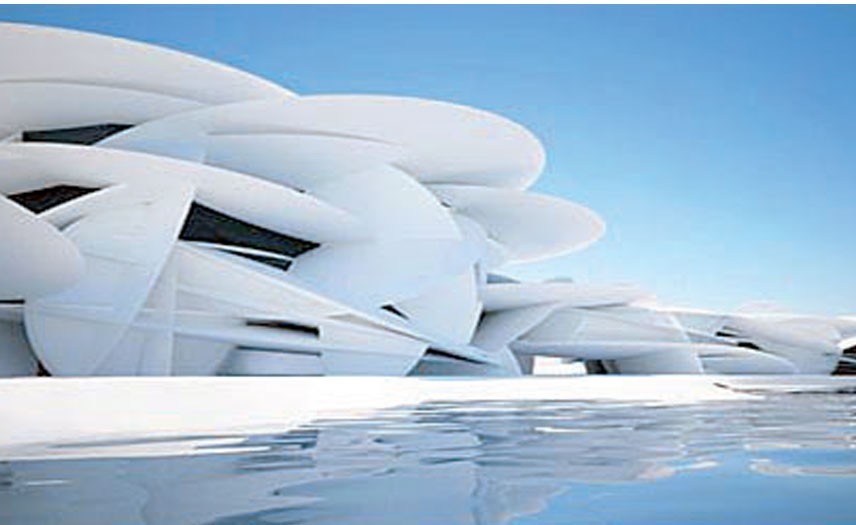+ A
A -
Elsa Exarhu
While for some the desert is an intimidating plain of dust and nothingness, for others, it looks like a major source of happiness and inspiration. The reality is that it was a way of life for the Bedouin.
Perhaps nothing symbolises this fragile environment more poignantly than sand roses. Sometimes referred to as desert roses. Easily destroyed, these are gypsum or barite crystals that condense into what look like rose petals.
Modelling the National Museum of Qatar after these delicate sand petals might explain the creative and poetic vision of its creator - Jean Nouvel.
After signing the Doha Tower design, French architect Nouvel conceived his second masterpiece: the National Museum of Qatar.
It is an organic architectural design that will appear to rise from the desert as the desert rose formations that are found in the Qatari sands.
Embodying the pride and traditions of Qatar's people, the museum will offer international visitors a dialogue about rapid change and modernisation.
The National Museum of Qatar will be the setting for a programme in which entire walls become cinematic displays, and innovative ways of projecting images and sounds will amaze its visitors through thematic displays of the collection's treasures.
Built around a historic structure, the Fariq Al Salatah Palace, which had served as a museum of heritage since 1975, the National Museum of Qatar is conceived and designed to unfold the story of the Qatari peninsula.
This museum will give voice to Qatar's heritage while celebrating its past and future together. Visitors will learn about Qatar's ancestors and the formation of early cities, the modernisation of Qatari society.
Exhibitions will combine historic objects and contemporary influences, opening up a dialogue about the impact of rapid change. Innovative presentation techniques will enchant audiences and push boundaries.
The 12 interwoven gallery spaces will hold the attention of patrons, as they traverse through the overall soundscape and visual story of Qatar projected on the very walls of the museum. Appropriate levels of acoustic separation, at times significant and at times subtle, will be the defining aural character of this new monument to the people and history of Qatar, and handheld mobile devices will guide people through thematic displays.
It will be a space for everyone: the interlocking disc designed by Jean Nouvel and inspired by the desert rose will be a thriving hub for the public, students, and museum professionals.
It will redefine the role of a cultural institution, fostering a spirit of participation and providing the conditions for discovery to thrive.
The building is constructed from pinkish-beige concrete. The aesthetic of layered plates on the exterior will be mirrored on the museum's interior. The floors will be of sand-coloured, polished concrete, while the vertical disk walls will be clad in a 'stuc-pierre', a traditional gymsum and lime-blended plaster formulated to imitate stone. The museum will be surrounded by a 1.2 million square foot landscaped park which interprets the Qatari desert landscape. The gardens are specifically designed to withstand the intense climate of Qatar. The flora and fauna will include native grasses and indigenous plants such as pomegranate tress, date palms, herbs and the national tree of Qatar, the Sidra tree.
The museum will have low water consumption while the landscape design will include sand dunes along with a stepped garden architecture, creating sitting areas and spaces for the museum's programmes of tours and garden lectures. A tour of the museum will provide visitors with a look at a group of galleries addressing three major interrelated themes: the natural history of the Qatar peninsula, the social and cultural history of Qatar, and the history of Qatar as a nation from the 18th century to the present day.
"A nomadic people builds its capital city and talks about it through this emblematic monument built with the most contemporary construction tools (steel, glass and fire concrete), and will communicate through high-definition cinema, incorporating visitors' movements into its museography: this museum is a modern-day caravanserai. From there you leave the desert and you return from it bringing back treasured images that remain forever engraved on your memory. this is more than just a metaphor. The National Museum of Qatar will become Qatar's voice of culture, delivering a message about the metamorphosis of modernity and the beauty that happens when the desert meets the sea." Jean Nouvel
The author, a Doha resident, is an avid reader of Qatar Tribune & can be contacted at [email protected]

